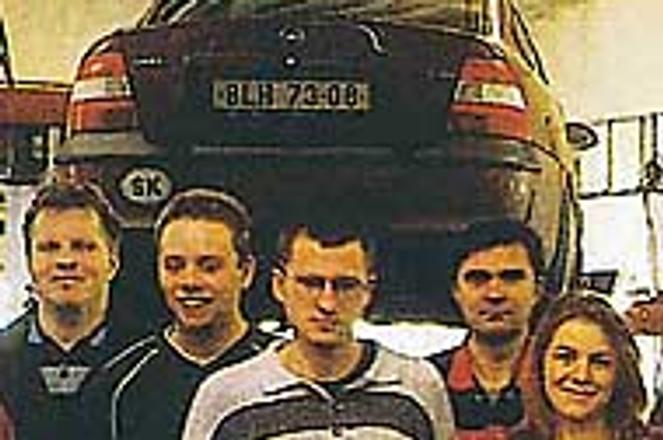REPAIR SHOP boss Juraj Jakabovič says business is booming as Slovaks spend time on other things than cars.photo: TASR
FOR MECHANIC Juraj Jakabovič, life is more work and less play than ever given the orders that keep streaming in to his Bratislava auto repair shop.
Jakabovič and his two sons now run a firm employing 14 people. Unlike shortly after the 1989 revolution, when he founded a tiny family company making its living from small repairs and selling auto-parts, Jakubovič now spends most of his time with managerial duties rather than blue-collar work.
The family's Bayern Center auto service company, as hundreds of others like it, has been driven forward by the social changes that followed the collapse of the communist regime. While before 1989 Slovaks tended to repair their own cars rather than hand them to mechanics in state-owned repair shops, increasing wealth, changing social patterns and ever more complex cars have given Jakabovič as much business as he can handle.
"People back then used to repair their cars themselves, with neighbour helping neighbour. Anyone who understood even the basics of cars and motors was able to fix mechanical problems through common sense in the garage," said Jaka-bovič, who began tinkering with cars at age 15.
0ther mechanics say that the 'social event' of working on cars with sons and neighbours was reinforced by cost concerns and a sense of pride from mastering the technical skills.
"Before the revolution, there was a bad financial situation in Slovakia. Only technically less skilled people such as doctors, teachers or bureaucrats had their cars fixed," said Miroslav Jurík, head of the Vepos - Autocentrum local repair shop in the north-east Slovak town of Levoča.
STARTING OUT almost a decade ago, Jakabovič had a small shop and few employees.photo: TASR
"When I drove a Trabant, things were clear. I could take it apart to the last screw according to the manual and then put it back together, and, surprisingly, it worked," added Ján Bunčák, a sociology professor with Comenius University in Bratislava and a former home mechanic.
The communist regime put great stress on manual work and technical knowledge, while white-collar work was correspondingly undervalued, Bunčák added.
The anti-communist revolution, however, brought a massive influx of business to repair shops as the 'fix-it' tradition disappeared and new social mores - such as the accumulation and display of personal wealth - took its place.
"People ceased to function according to the self-help principle and started to rely on repair shops more after the revolution," said Jakabovič. "In the beginning, car nuts and garage wizards started to repair cars professionally, first at small garages, which were later merged, and later by renting bigger halls."
Jakabovič's company, after two years on the outskirts of Bratislava in the Petržalka suburb, moved in 1994 to a larger hall in Mlynské Nivy, closer to the centre of the city.
In moving, Jakabovič was profiting from a new social class of entrepreneur who had no time for self-repair, but did have the money to pay someone else to do it.
"Businessmen now have no time for such things, and after work are too exhausted to lift a car hood. They also have the money to send a car to a repair shop. According to their way of thinking, the car is supposed to serve the owner, not the other way around," said Jakabovič.
Sociologist Bunčák agreed. "Today's big modern cars are owned by people who treasure their time too much to spend it on nonsense like this. The value of people's time has changed."
But perhaps the important factor behind the change, say industry experts, is that the technical complexity of the average car has grown beyond the ability of home mechanics to repair.
"The cars that were on the road started to change significantly after the revolution. Our handymen started to have problems in their garages, because cars were becoming more technically advanced. This forced the owners to pay for the services of the companies where they bought their cars, because Škoda was no longer the only brand on the market," said Jurík.
"The modern car cannot be repaired without special tools. Modern car firms even somehow prevent the amateur from having access to the equipment needed to fix them," said Baňák.
The various post-revolution changes in both attitudes towards car repair and the time, skill and money needed to do it created an immense boom in the auto repair industry. While the Slovak Statistics Office does not keep independent data on car repair sector turnover, including them in overall data for sales of parts, mechanics themselves say they are in awe of the business that has come their way.
"Before the revolution there was an average of one repair shop per town of 10,000 inhabitants. I can't estimate exactly, but I would say the number of these shops has grown 500 per cent since then," said Jurík.
"[When we moved from Petržalka,] we had two hoists, two mechanics and one electrician. But the customers kept coming, so we had to expand," said Jakabovič.
"And business just keeps getting better."
It may take some years, however, before repair shops take over all car-repair activities in the country.
Experts say the DIY tradition still survives among poorer people and in rural areas, where older models of cars are more common than new.
"For older, pre-1985 models, it's still in some ways possible to mess around with them, because it's easy. It's also financially attractive to do it by yourself, because brand repair shops now charge almost Sk1,000 [$23] per hour. Imagine you're an ordinary citizen making the average wage [Sk13,000 a month], and the repair of your car takes three hours - you'd probably just say 'thank you very much'," said Jakabovič.


